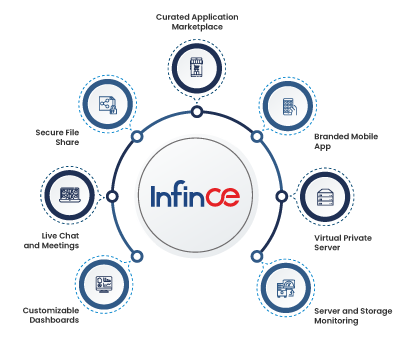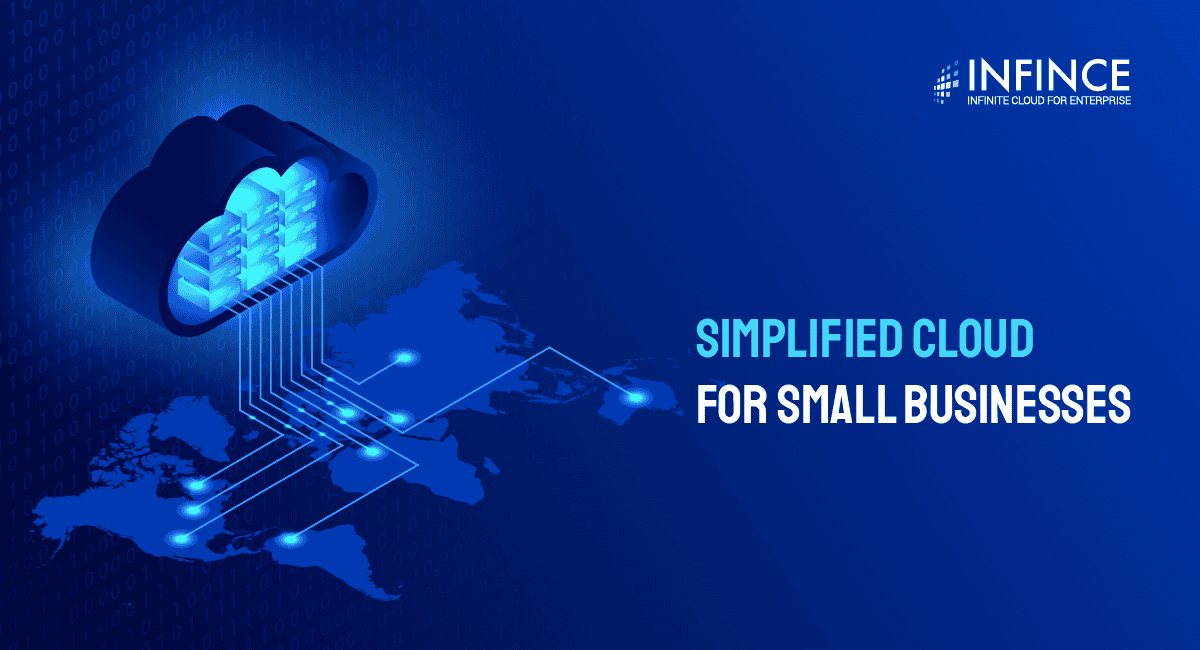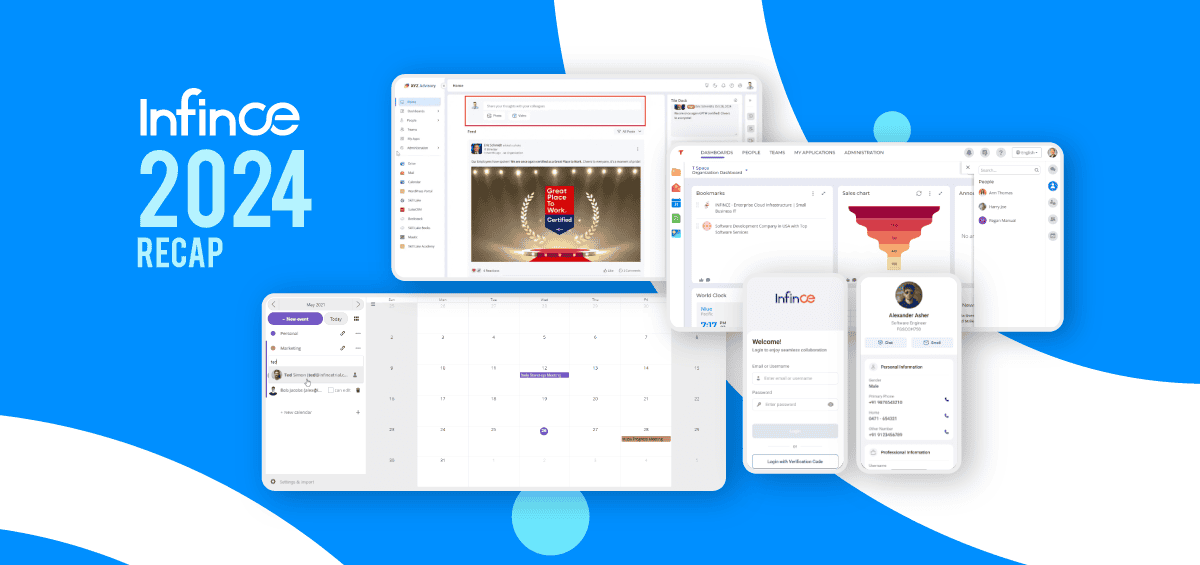Table of Contents
- Brief Overview
- What is an Enterprise Cloud Suite?
- What Are the Primary Components of an Enterprise Cloud Suite?
- What Are the Key Features of an Enterprise Cloud Suite?
- What Are the Potential Benefits of Leveraging an Enterprise Cloud Suite?
- How Did Infince Help Five Brothers Achieve Operational Efficiency for Their Customers?
- What Are the Factors to Consider in Assessing the Right Enterprise Cloud Suite?
- Why Infince? Your Go-to Enterprise Cloud Suite
By 2025, it’s estimated that more than 80% of enterprises will have moved to the cloud. Gartner reports that by 2028, cloud computing will change from being a technology disruptor to becoming a mandatory investment for maintaining business continuity.
Transforming the enterprise landscape, cloud-based solutions have become the magic bullet that businesses have been leveraging to streamline their operations and enhance productivity. The evolution of the cloud has been phenomenal, as it is now available as a full-scale enterprise cloud suite working as an all-in-one digital toolkit. So, whether a business is aiming to improve collaboration, enhance security, or support remote work, an enterprise cloud suite is a sure-shot ticket to achieving those goals.
What is an Enterprise Cloud Suite?
In simple terms, an enterprise cloud suite is a tightly knit or integrated set of cloud-based apps and platforms that bring together several essential business functions. Think of collaboration systems, data storage, multiple apps on a marketplace, productivity tools, and more, all under a single umbrella.
Essentially, it is an all-in-one solution on the cloud meant to streamline business operations and enhance workplace efficiency.
As the modern business landscape demands agility and flexibility, an enterprise cloud suite integrates various business processes into a unified solution, thus offering benefits of productivity, efficiency, and sustained business continuity. In essence, an enterprise cloud suite forms the backbone of an enterprise’s everyday functioning, ensuring improved productivity and a positive bottom line.
What Are the Primary Components of an Enterprise Cloud Suite?
An enterprise cloud suite comprises several integral components built into a unified system to drive efficiency and workplace productivity. Here’s a breakdown of the primary elements:
-
- Cloud data storage allows organizations to store, access, and manage data securely from anywhere, ensuring flexibility and scalability as the business grows.
-
- Collaboration systems comprise real-time applications for video conferencing, shared document editing, and cloud-integrated communication tools that facilitate seamless teamwork across different locations and time zones.
-
- Productivity tools such as social intranet and email platforms, calendars, and workplace feeds to help individuals and teams keep a tab on the workflow of their and share, collaborate, and deliver work effectively.
-
- Mobile-optimized applications ensure that team members have access to critical business functions and can perform tasks or access information from their smartphones or tablets, enhancing accessibility and operational continuity.
- Dynamic admin tools such as role-based operational dashboards facilitate real-time communication and collaboration among co-workers via a secure cloud.
As a leading enterprise cloud suite, Infince addresses several pain points that plague enterprises in the areas of collaboration and communication. From sophisticated data storage options on the cloud to powerful collaboration tools, Infince integrates various functionalities to cater to the ever-evolving needs of modern-day enterprises.
What Are The Key Features of an Enterprise Cloud Suite?
Regarding an enterprise cloud suite, the right set of features that pack a punch makes all the difference. Here are the key features that make an enterprise cloud suite cut through the noise and establish itself as a powerhouse behind today’s business operations.
-
- Comprehensive Integration: It integrates seamlessly across the board
Comprehensive Integration is one of the standout features of an enterprise cloud suite. Its ability to integrate multiple tools and apps under a single unified system without disrupting business as usual allows for several benefits, such as enhanced team collaboration through shared workspaces, centralized access to productivity tools for improved efficiency, and, of course, unified data management for reducing data silos and inconsistencies.
Since effective communication is the holy grail of successful enterprises, integrated messaging tools ensure everyone is informed and on the same page. These tools include instant real-time chat and video communication tools. Additionally, virtual meetings break down physical barriers through high-quality video conferencing tools, fostering effective communication among geographically dispersed teams.
- Comprehensive Integration: It integrates seamlessly across the board
-
- Powerful Scalability & Flexibility: It scales effortlessly to adapt to a growing enterprise’s needs
Enterprise cloud suites that scale to adapt according to an enterprise’s growth ensure continuous support as the business evolves. Scalability comes with flexibility and cost-effectiveness because it reduces repeated investments in expensive hardware with growing needs. For example, subscribing to a pay-as-you-go model allows businesses to scale resources based on current needs without significant upfront investment in hardware. This level of flexibility allows businesses to focus on their core business objectives without running high and dry worrying about customization and configuration woes as they grow significantly.
- Powerful Scalability & Flexibility: It scales effortlessly to adapt to a growing enterprise’s needs
- Robust Security & Safety: It is secure and ensures compliance
An enterprise cloud suite needs to be built with strong data encryption protocols to safeguard data both at rest and in transit, ensuring the confidentiality and integrity of sensitive information. Additionally, strong access controls allow for granular permissions. Adhering to industry standards and regulations means that data handling practices meet stringent security requirements.
What Are The Potential Benefits of Leveraging an Enterprise Cloud Suite?
-
- Enhanced collaboration leads to improved teamwork and communicationAs a modern-day business that needs to sustain the digital disruptors of today, enterprises need to be on their toes regarding collaboration and effective communication. An enterprise cloud suite is typically equipped with various collaboration tools, such as shared calendars, document management systems, and instant messaging platforms. These tools enable seamless communication and coordination among team members, regardless of their location. Enhanced collaboration leads to more efficient project management and a cohesive work environment, fostering innovation and quick problem-solving. Don’t we all agree that a cohesive working environment naturally translates to a productive workforce? Well, there are statistics that are proof of it. McKinsey reports that improved collaboration through digital technologies can raise the productivity of interaction by 20-25%.
-
- Improved operational efficiencyA Deloitte study indicates that automation can save businesses up to 30% in operational costs. Tailored business insights and data visualizations alongside comprehensive office applications can boost decision-making and workplace productivity.
-
- Cost-effective cloud systemsEnterprise cloud suites that are armed with collaboration apps, business phone systems, and centralized IT infrastructure facilitate seamless communication and efficient project management across teams, owing to their highly integrated nature that obviates the need for conventional subscription hardware. Being scalable and flexible adds to several cost savings regarding resources and individual investments for every business function since several important aspects are integrated within a comprehensive enterprise cloud suite.
- Improved compliance and securityAn enterprise cloud suite is typically equipped with private IT Infrastructure to simplify IT operations by centralizing application management and offering a controlled, secure IT environment, enhancing both security and regulatory compliance.
How Did Infince Help Five Brothers Achieve Operational Efficiency for Its Customers?
Customer needs are fast evolving, so enterprises need to be agile to cater to their diverse needs. One major competitive advantage that enterprises can leverage is investing in an enterprise cloud suite that helps them offer their customers a more agile business. Let’s look at a couple of examples to see how an enterprise cloud suite can be a differentiating factor for success.
One prominent example is how Five Brothers, an asset management solutions company, leveraged Infince as a project management tool to start with. Considering its successful run, they moved to try out Infince’s enterprise cloud suite capabilities. Currently, Five Brothers’ workforce (both remote and hybrid) is seeing the tangible benefits of Infince’s enterprise cloud suite. Multi-level dashboards, shared feeds among employees, mobile apps, and more have all cultivated a culture of trust and enhanced workplace collaboration. Even better is how centralized data accessibility has alleviated their initial struggles with poor communication and scattered data.
The result: a significant improvement in team collaboration and operational efficiency, a reduction in dependency on legacy systems, and greater readiness for the future.
What Are the Factors to Consider in Assessing the Right Enterprise Cloud Suite?
Selecting the ideal enterprise cloud suite necessitates a holistic evaluation of various factors to ensure alignment with your business goals:
-
- Your unique business needs and challenges: Identify the specific functionalities your business requires. Does the enterprise cloud suite support your workflow, industry-specific needs, and user roles?
-
- Does it have powerful integration capabilities: Consider how well the enterprise cloud suite can integrate with your existing tools and systems. This is key to making sure that it fits seamlessly and doesn’t cause more data silos.
-
- Is it scalable? When growth is your number one goal, scalability is second nature to consider. Does your enterprise cloud suite have the power to scale efficiently as your business grows, supporting increased demand without performance compromises?
-
- What are the costs? Evaluate both the initial investment and the ongoing operational costs. A cost-effective solution that offers transparency in pricing without hidden fees is vital.
- What kind of support is available? Look for robust support services, including training, troubleshooting, and regular updates that help maintain operational continuity.
Why Infince? Your Go-to Enterprise Cloud Suite
Infince stands out in the crowded market of enterprise cloud suites due to several differentiating factors. Let’s get to the specifics. Small and medium-sized businesses often juggle limited IT resources but are always in pursuit of leveraging advanced technology. Here’s where Infince emerges as a game-changer. It goes beyond just enhancing enterprise operational efficiency and tailors its features to best suit each business’s unique dynamics.
One of the standout features is the customizable dashboards. Employees can have dashboards tailored to their specific roles and functions, ensuring that everyone has the information they need right at their fingertips. Custom dashboards built with drag-and-drop tiles keep your employees engaged by allowing you to share quick updates and announcements. This includes company announcements, team updates, important documents, upcoming events, and celebrations.
Overall, this translates into a solution sculpted around your business needs without the usual hefty IT overhead.
Addressing the big albatross in today’s vulnerable threat landscape – Infince offers advanced data protection through its unique virtual private infrastructure. Hosted on a virtual private server (VPS), Infince mitigates the risk of data leaks and unauthorized access by third-party applications, which is a common issue in multi-tenant solutions. The digital workplace ensures that your data remains private and secure, free from data mining and exploitation typically seen with shared hosting environments. With Infince’s VPS, your organization can confidently manage sensitive information, knowing that robust security measures are in place to prevent breaches and maintain data integrity.
And then there’s support. Anyone who’s run a business knows the frustration of hitting a snag and languishing in helpdesk limbo. Infince sidesteps this entirely with a dedicated support team that’s as quick as it is proficient, ensuring your issues get resolved promptly and letting you stay focused on what you do best—running your business.
Lastly, pricing. In today’s economy, every dollar counts. Infince not only offers competitive pricing but pairs it with transparent billing. With a pay-for-what-you-use model, users can select the features they need and only pay for those, making it a truly customizable platform. This approach allows businesses to optimize their resources and invest wisely in the tools that matter most to them.
Infince isn’t just another tool—it’s a strategic asset for businesses serious about scaling smartly and sustainably.
Explore more opportunities with Infince. Request a free demo now!














































